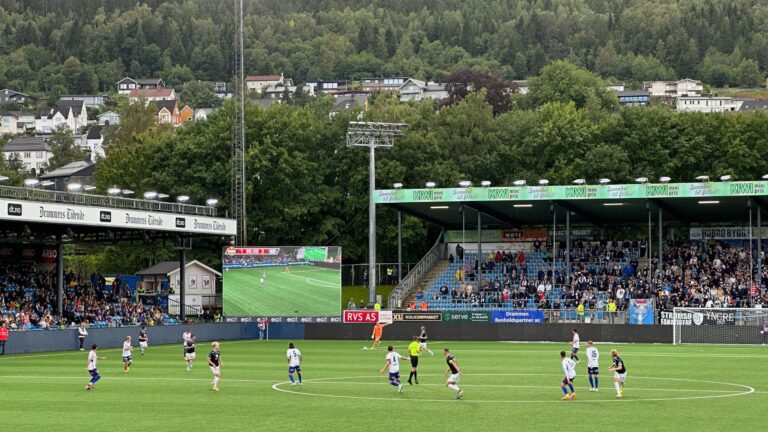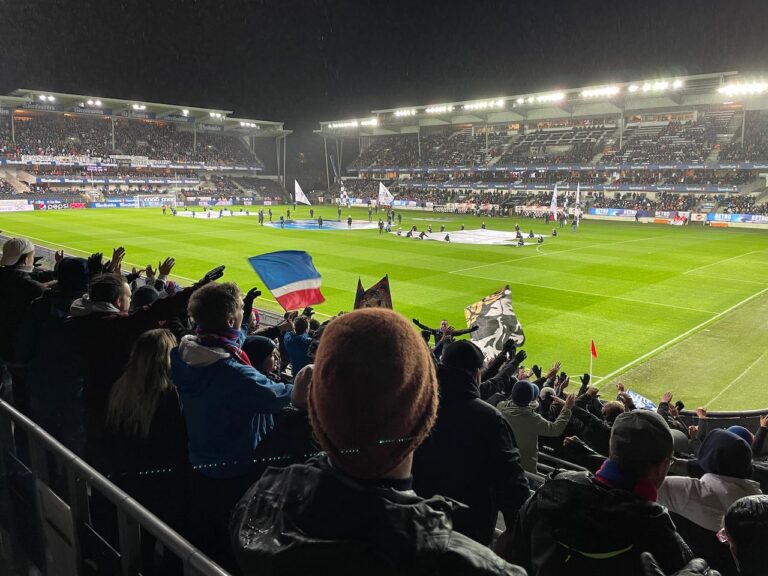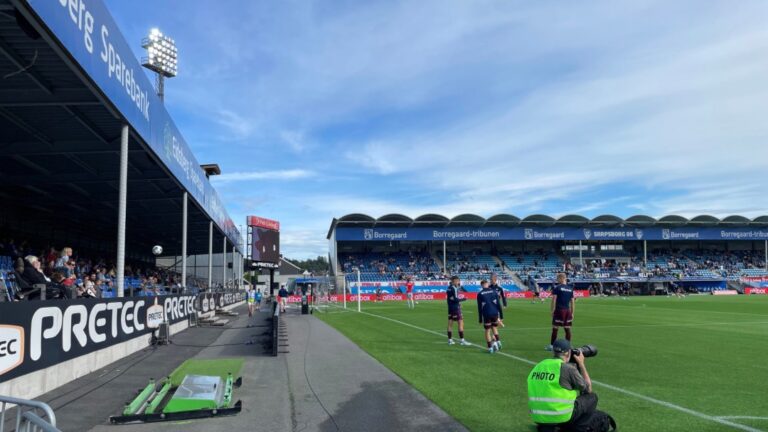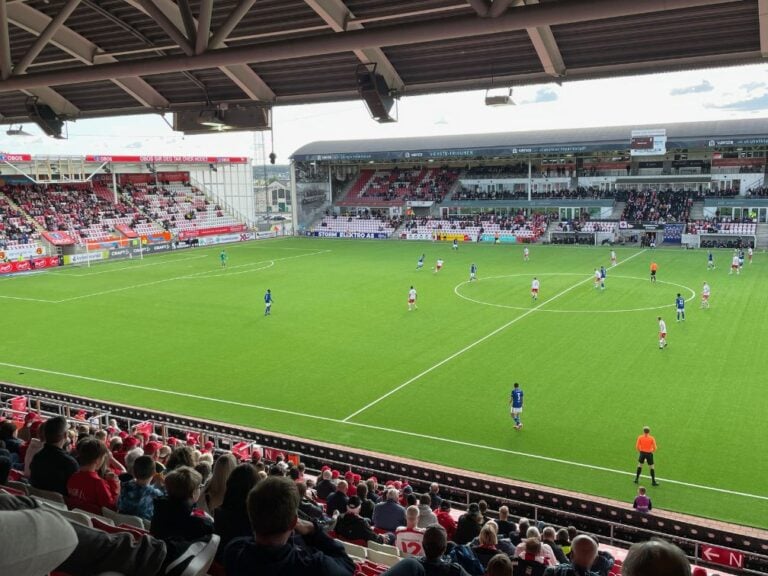Are you a football fan new to Norway or planning a trip to see a game? Here’s what you need to know about the top competition in professional football in Norway.
In 2023, Bodø/Glimt secured their third Eliteserien title in four years, finishing the season nine points clear of closest rivals Brann and Molde. Their run of nine wins in their first 10 games put them in a position they were never likely to lose.

The title win caps a fantastic few years for the club from the small Norwegian city north of the Arctic circle. The club has also performed well on the European stage, drawing admiring glances from pundits in other countries.
Glimt will understandably start the 2024 edition of Eliteserien as favourites to win the title again. But there are many clubs raring to go for a chance to knock them off their perch.
Watching Football in Norway
You could be forgiven for thinking football in Norway is nothing more than the English Premier League. On a typical weekend, you’ll see Liverpool and Manchester United flags on housing estates up and down the land.
Despite the obsession with English football in Norway, interest in the domestic game is definitely growing. Attendances are up, and some high-profile player sales have drawn interest from abroad.
It took me a while to get into Norwegian football, but now I watch games from other countries far less frequently than I once did.
Watching live football is so much better than watching the game on TV, while supporting a club helps you to understand Norwegian culture and even helps you learn the language faster.

So if you’ve moved to Norway and you’re keen to discover Norwegian football, or perhaps you’re a groundhopper planning a trip to Norway, read on for a complete guide to Eliteserien, the top level of men’s professional football in Norway.
Eliteserien and the Norwegian Football System
First things first, football in Norway is a summer sport. While there are plenty of indoor facilities and artificial pitches, competitive football always takes place between April and November.
Eliteserien (the Elite Series) is the top level of football in Norway. Sixteen teams compete for the title, playing each other home and away for a total of 30 games. Games are mostly played on Sunday evenings.
Below Eliteserien sits the first division, currently known because of sponsorship as OBOS-ligaen. Below this, the football system is regional.
The two teams finishing with the fewest amount of points in Eliteserien are automatically relegated to OBOS-ligaen, and replaced with the best two teams from OBOS-ligaen. The third-worst team must play-off with the winners of a play-offf competition from OBOS-ligaen for the right to play in Eliteserien the following year.
At the time of writing, the Eliteserien champions enter the qualifying rounds for the UEFA Champions League, while the clubs finishing second and third enter the qualifying rounds for the UEFA Conference League.
This is subject to change depending on how Norwegian clubs perform in Europe, and the performance of Norway’s national team.
Eliteserien in Recent Years
Despite both clubs coming from relatively small Norwegian cities, Bodø/Glimt and Molde have dominated Eliteserien in the past few seasons.

Bodø/Glimt won the league in 2023. Molde's title win in 2022 came after successive titles for Glimt in 2020 and 2021. In 2019, Molde won the title, which brought to an end a run of four successive titles for Rosenborg.
Despite the success of these two teams in recent years, Rosenborg is by far the most successful club in Norway with 26 title wins.
During the 1990s and early 2000s, the club won an astonishing 13 consecutive titles, as part of a run of 16 out of 19 titles between 1988 and 2006. Rosenborg also recorded a handful of Norwegian Cup wins during that era.
A History of Eliteserien
Eliteserien's birth can be traced back to 1937 as Norgesserien. Before its inception, Norway only had regional leagues and the Norwegian Cup.
Initially structured with teams from eight districts, Norgesserien champions were crowned through playoffs or finals. The first victory went to Fredrikstad in the 1937-38 season, who defeated Lyn with a 4-0 aggregate score.
World War II halted the plans to transform district leagues into a national competition.
Post-war, in 1948, the Hovedserien emerged, with 16 top teams divided into two groups. By 1963, after a lengthy transitional season called the Maratonserien, the league evolved into 1. divisjon, a single division format.

Restrictions placed on teams from Northern Norway were lifted in the 1970s, creating a truly national league for the first time.
By 1990, with sponsorship from Norsk Tipping, the league adopted the name Tippeligaen. From the 2017 season onwards, the league has been referred to without a sponsor name as just Eliteserien.
Norway’s Eliteserien in numbers
The top flight of Norwegian football has seen many teams come and go. So, it’s always interesting to dive into the history by looking at some facts and figures.
Eliteserien title wins
Which clubs are the most successful? Seventeen different clubs have won the title since the league’s creation in 1937.
They are: Rosenborg (26), Fredrikstad (9), Viking (8), Lillestrøm (5), Molde (5), Vålerenga (5), Brann (3), Larvik Turn (3), Bodø/Glimt (2), Lyn (2), Start (2), Strømsgodset (2), Fram Larvik (1), Freidig (1), Moss (1), Skeid (1), and Stabæk (1).
Are you a fan of Norway’s Eliteserien? Let us know your experiences of watching games in the comments below.


Hi David,
enjoy the website and have subscribed for some time now.
Jei er halv Norsk, min mor kommer fra Haugesund!
I’ve attended a few FKH games over the years. Generally great atmosphere and nice food options at the kiosk.
I remember one year the youth teams were trying to raise money so there was fresh waffles being made within the stadium perimeter – superb!
Looking forward to go again whenever we next visit.
Cheers from Scotland.
Gordon
Next time an entire article is written about Norwegian soccer could the women at least be mentioned please?
This article is specifically about the Eliteserien, which is the top level of men’s football. We have other articles about Norwegian football in general (which mention women’s football) and specifically women’s football. But hey, why bother searching first when you can jump to conclusions eh?